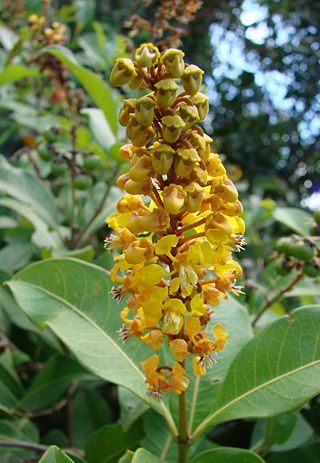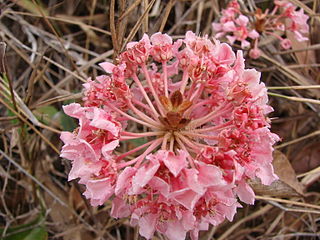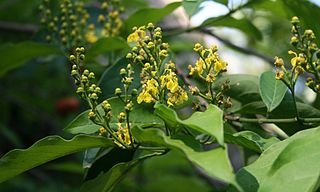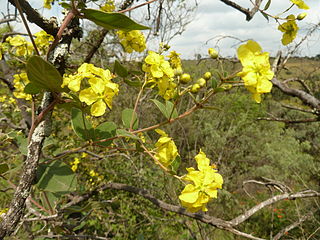
Adrien-Henri de Jussieu was a French botanist.

Malpighiaceae is a family of flowering plants in the order Malpighiales. It comprises about 73 genera and 1315 species, all of which are native to the tropics and subtropics. About 80% of the genera and 90% of the species occur in the New World and the rest in the Old World.

Byrsonima is one of about 75 genera in the Malpighiaceae, a family of flowering plants in the order Malpighiales. In particular in American English, they are known as locustberries. Another widely seen common name is serrets or serrettes.

Pterandra is a genus in the Malpighiaceae, a family of about 75 genera of flowering plants in the order Malpighiales. Pterandra comprises 15 species of trees, shrubs, and subshrubs, all but two native to South America, principally Colombia, Venezuela, and Brazil; the exceptions are from Panama. There are only some ornamental plants introduced in China, and there are no native varieties.

Franz Josef Niedenzu was a German botanist born in Köppernig. He is remembered for his work with the botanical family Malpighiaceae.

Bunchosia is a genus in the Malpighiaceae, a family of about 75 genera of flowering plants in the order Malpighiales. It contains roughly 75 species of trees and shrubs, which are native to dry woodlands, savannas, and wet forests. Their range extends from Mexico and the Caribbean to southeastern Brazil and adjacent Argentina. Bunchosia is one of three arborescent genera of Malpighiaceae with fleshy, bird-dispersed fruits.
Diplopterys is a genus of plants in the Malpighiaceae family.
The APG III system of flowering plant classification is the third version of a modern, mostly molecular-based, system of plant taxonomy being developed by the Angiosperm Phylogeny Group (APG). Published in 2009, it was superseded in 2016 by a further revision, the APG IV system.

Sphedamnocarpus is a plant genus in the Malpighiaceae, consisting of some 10 to 18 species. They are native to Sub-Saharan Africa and Madagascar, and may be subshrubs, shrubs or climbers. Their mostly yellow flowers have 5 sepals and 5 petals. The 3 to 4-locular ovaries develop into samaras.

The APG IV system of flowering plant classification is the fourth version of a modern, mostly molecular-based, system of plant taxonomy for flowering plants (angiosperms) being developed by the Angiosperm Phylogeny Group (APG). It was published in 2016, seven years after its predecessor the APG III system was published in 2009, and 18 years after the first APG system was published in 1998. In 2009, a linear arrangement of the system was published separately; the APG IV paper includes such an arrangement, cross-referenced to the 2009 one.
Spachea elegans is a species of flowering plants in the family Malpighiaceae. It is found in Brazil and Venezuela.

Tetrapterys is a genus of flowering plants in the family Malpighiaceae, native to Latin America and the Caribbean, from Mexico through to Argentina, but excluding Chile. Small trees, shrubs or vines, they are known to be toxic to livestock if consumed for long periods of time, and T. mucronata and T. styloptera have hallucinogenic effects in humans similar to ayahuasca.
Verrucularina is a genus of flowering plants belonging to the family Malpighiaceae.
Aenigmatanthera is a genus of flowering plants belonging to the family Malpighiaceae.
Aspicarpa is a genus of flowering plants belonging to the family Malpighiaceae.
Camarea is a genus of flowering plants belonging to the family Malpighiaceae.

Niedenzuella is a genus of flowering plants belonging to the family Malpighiaceae.

Gaudichaudia is a genus of flowering plants belonging to the family Malpighiaceae.
Andersoniodoxa is a small genus of flowering plants in the family Malpighiaceae, native to Costa Rica, Colombia, and northern Brazil. A molecular and morphological study showed that its species, formerly included in Lophanthera, were more closely related to Spachea, requiring a new genus to be erected.










